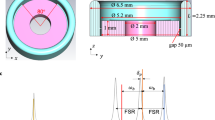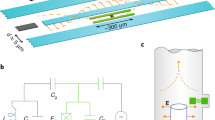Abstract
Superconducting circuits are promising candidates for constructing quantum bits (qubits) in a quantum computer; single-qubit operations are now routine1,2, and several examples3,4,5,6,7,8,9 of two-qubit interactions and gates have been demonstrated. These experiments show that two nearby qubits can be readily coupled with local interactions. Performing gate operations between an arbitrary pair of distant qubits is highly desirable for any quantum computer architecture, but has not yet been demonstrated. An efficient way to achieve this goal is to couple the qubits to a ‘quantum bus’, which distributes quantum information among the qubits. Here we show the implementation of such a quantum bus, using microwave photons confined in a transmission line cavity, to couple two superconducting qubits on opposite sides of a chip. The interaction is mediated by the exchange of virtual rather than real photons, avoiding cavity-induced loss. Using fast control of the qubits to switch the coupling effectively on and off, we demonstrate coherent transfer of quantum states between the qubits. The cavity is also used to perform multiplexed control and measurement of the qubit states. This approach can be expanded to more than two qubits, and is an attractive architecture for quantum information processing on a chip.
This is a preview of subscription content, access via your institution
Access options
Subscribe to this journal
Receive 51 print issues and online access
$199.00 per year
only $3.90 per issue
Buy this article
- Purchase on Springer Link
- Instant access to full article PDF
Prices may be subject to local taxes which are calculated during checkout




Similar content being viewed by others
References
Devoret, M. H. & Martinis, J. M. Implementing qubits with superconducting integrated circuits. Quantum Inform. Process. 3, 163–203 (2004)
You, J. Q. & Nori, F. Superconducting circuits and quantum information. Phys. Today 58, 42–47 (2005)
Yamamoto, T., Pashkin, Y. A., Astafiev, O., Nakamura, Y. & Tsai, J. S. Demonstration of conditional gate operation using superconducting charge qubits. Nature 425, 941–944 (2003)
Berkley, A. J. et al. Entangled macroscopic quantum states in two superconducting qubits. Science 300, 1548–1550 (2003)
Majer, J. B., Paauw, F. G., ter Haar, A. C. J., Harmans, C. J. P. M. & Mooij, J. E. Spectroscopy on two coupled superconducting flux qubits. Phys. Rev. Lett. 94, 090501 (2005)
Steffen, M. et al. Measurement of the entanglement of two superconducting qubits via state tomography. Science 313, 1423–1425 (2006)
Hime, T. et al. Solid-state qubits with current-controlled coupling. Science 314, 1427–1429 (2006)
van der Ploeg, S. H. W. et al. Controllable coupling of superconducting flux qubits. Phys. Rev. Lett. 98, 057004 (2007)
Niskanen, A. O. et al. Quantum coherent tunable coupling of superconducting qubits. Science 316, 723–726 (2007)
Cirac, J. I. & Zoller, P. Quantum computations with cold trapped ions. Phys. Rev. Lett. 74, 4091–4094 (1995)
Leibfried, D., Blatt, R., Monroe, C. & Wineland, D. Quantum dynamics of single trapped ions. Rev. Mod. Phys. 75, 281–324 (2003)
Duan, L. M., Lukin, M. D., Cirac, J. I. & Zoller, P. Long-distance quantum communication with atomic ensembles and linear optics. Nature 414, 413–418 (2001)
Chou, C.-W. et al. Functional quantum nodes for entanglement distribution over scalable quantum networks. Science 316, 1316–1320 (2007)
Mabuchi, H. & Doherty, A. C. Cavity quantum electrodynamics: coherence in context. Science 298, 1372–1377 (2002)
Hagley, E. et al. Generation of Einstein-Podolsky-Rosen pairs of atoms. Phys. Rev. Lett. 79, 1–5 (1997)
Zheng, S.-B. & Guo, G.-C. Efficient scheme for two-atom entanglement and quantum information processing in cavity QED. Phys. Rev. Lett. 85, 2392–2395 (2000)
Osnaghi, S. et al. Coherent control of an atomic collision in a cavity. Phys. Rev. Lett. 87, 037902 (2001)
Blais, A., Huang, R.-S., Wallraff, A., Girvin, S. M. & Schoelkopf, R. J. Cavity quantum electrodynamics for superconducting electrical circuits: an architecture for quantum computation. Phys. Rev. A. 69, 062320 (2004)
Wallraff, A. et al. Strong coupling of a single photon to a superconducting qubit using circuit quantum electrodynamics. Nature 431, 162–167 (2004)
Houck, A. A. et al. Generating single microwave photons in a circuit. Nature 449, 328–331 (2007)
Koch, J. et al. Charge insensitive qubit design derived from the Cooper Pair Box. Phys. Rev. A (in the press); preprint at 〈http://arxiv.org/abs/cond-mat/0703002〉 (2007)
Blais, A. et al. Quantum-information processing with circuit quantum electrodynamics. Phys. Rev. A. 75, 032329 (2007)
Schuster, D. I. et al. ac Stark shift and dephasing of a superconducting qubit strongly coupled to a cavity field. Phys. Rev. Lett. 94, 123602 (2005)
Gershenfeld, N. A. & Chuang, I. L. Bulk spin-resonance quantum computation. Science 275, 350–356 (1997)
Schuster, D. I. et al. Resolving photon number states in a superconducting circuit. Nature 445, 515–518 (2007)
Grangier, P., Aspect, A. & Vigue, J. Quantum interference effect for two atoms radiating a single photon. Phys. Rev. Lett. 54, 418–421 (1985)
Itano, W. M. et al. Complementarity and Young’s interference fringes from two atoms. Phys. Rev. A. 57, 4176–4187 (1998)
Wallraff, A. et al. Approaching unit visibility for control of a superconducting qubit with dispersive readout. Phys. Rev. Lett. 95, 060501 (2005)
Acknowledgements
This work was supported in part by the National Security Agency under the Army Research Office, by the NSF, and by Yale University. J.M.C. acknowledges support from an NSF Graduate Research Fellowship. J.K. and A.A.H. acknowledge support from Yale University via a Quantum Information and Mesoscopic Physics Fellowship. L.F. acknowledges partial support from the CNR-Istituto di Cibernetica, Pozzuoli, Italy. A.B. was supported by NSERC, CIAR and FQRNT.
Author information
Authors and Affiliations
Corresponding authors
Ethics declarations
Competing interests
Reprints and permissions information is available at www.nature.com/reprints. The authors declare no competing financial interests.
Rights and permissions
About this article
Cite this article
Majer, J., Chow, J., Gambetta, J. et al. Coupling superconducting qubits via a cavity bus. Nature 449, 443–447 (2007). https://doi.org/10.1038/nature06184
Received:
Accepted:
Issue Date:
DOI: https://doi.org/10.1038/nature06184
This article is cited by
-
Programmable Heisenberg interactions between Floquet qubits
Nature Physics (2024)
-
Single-Photon Source with Emission Direction Controlled by a Qubit State
Journal of Low Temperature Physics (2023)
-
A Review of Developments in Superconducting Quantum Processors
Journal of the Indian Institute of Science (2023)
-
Noisy intermediate-scale quantum computers
Frontiers of Physics (2023)
-
Quantum routing in planar graph using perfect state transfer
Quantum Information Processing (2023)
Comments
By submitting a comment you agree to abide by our Terms and Community Guidelines. If you find something abusive or that does not comply with our terms or guidelines please flag it as inappropriate.



